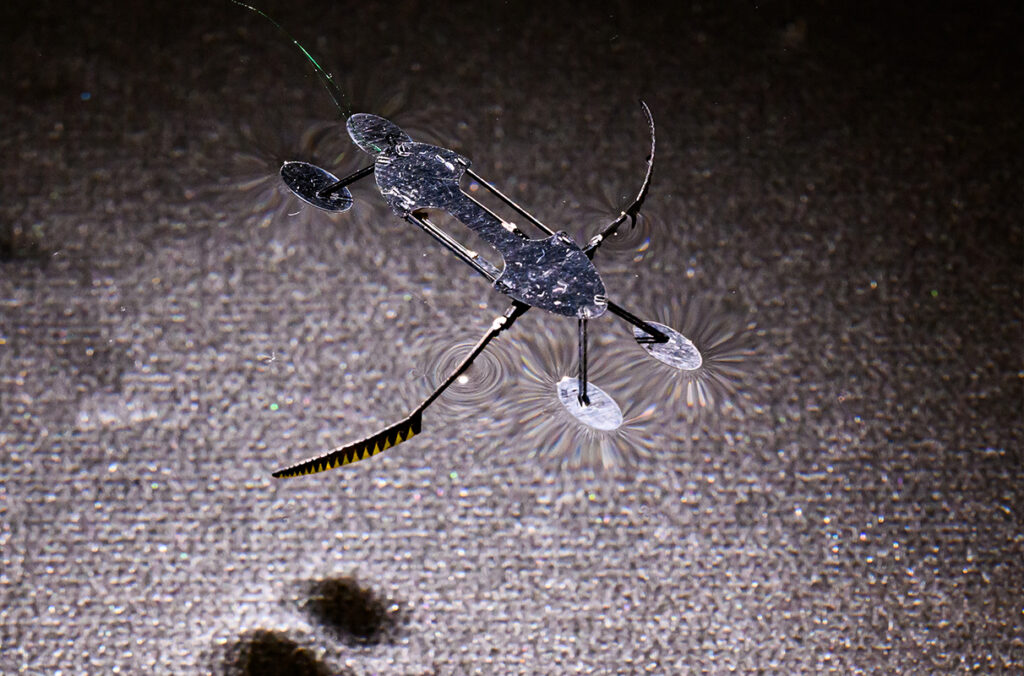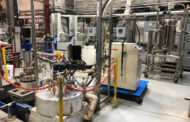
The WaterStrider weighs 55 milligrams and can move at 6 millimeters per second
(photo by Bob Hubner, WSU Photo Services).
Two insect-like robots, a mini-bug and a water strider, developed at Washington State University, are the smallest, lightest and fastest fully functional micro-robots ever known to be created.
Such miniature robots could someday be used for work in areas such as artificial pollination, search and rescue, environmental monitoring, micro-fabrication or robotic-assisted surgery. Reporting on their work in the proceedings of the IEEE Robotics and Automation Society’s International Conference on Intelligent Robots and Systems, the mini-bug weighs in at eight milligrams while the water strider weighs 55 milligrams. Both can move at about six millimeters a second.
“That is fast compared to other micro-robots at this scale although it still lags behind their biological relatives,” said Conor Trygstad, a PhD student in the School of Mechanical and Materials Engineering and lead author on the work. An ant typically weighs up to five milligrams and can move at almost a meter per second.
The key to the tiny robots is their tiny actuators that make the robots move. Trygstad used a new fabrication technique to miniaturize the actuator down to less than a milligram, the smallest ever known to have been made.
“The actuators are the smallest and fastest ever developed for micro-robotics,” said Néstor O. Pérez-Arancibia, Flaherty Associate Professor in Engineering at WSU’s School of Mechanical and Materials Engineering who led the project.
The actuator uses a material called a shape memory alloy that is able to change shapes when it’s heated. It is called ‘shape memory’ because it remembers and then returns to its original shape. Unlike a typical motor that would move a robot, these alloys don’t have any moving parts or spinning components.
“They’re very mechanically sound,” said Trygstad. “The development of the very lightweight actuator opens up new realms in micro-robotics.”
Shape memory alloys are not generally used for large-scale robotic movement because they are too slow. In the case of the WSU robots, however, the actuators are made of two tiny shape memory alloy wires that are 1/1000 of an inch in diameter. With a small amount of current, the wires can be heated up and cooled easily, allowing the robots to flap their fins or move their feet at up to 40 times per second. In preliminary tests, the actuator was also able to lift more than 150 times its own weight.
Compared to other technologies used to make robots move, the SMA technology also requires only a very small amount of electricity or heat to make them move.
“The SMA system requires a lot less sophisticated systems to power them,” said Trygstad.
Trygstad, an avid fly fisherman, has long observed water striders and would like to further study their movements. While the WSU water strider robot does a flat flapping motion to move itself, the natural insect does a more efficient rowing motion with its legs, which is one of the reasons that the real thing can move much faster.
The researchers would like to copy another insect and develop a water strider-type robot that can move across the top of the water surface as well as just under it. They are also working to use tiny batteries or catalytic combustion to make their robots fully autonomous and untethered from a power supply.
Original Article: Mini-robots modeled on insects may be smallest, lightest, fastest ever developed
More from: Washington State University
The Latest Updates from Bing News
Go deeper with Bing News on:
Micro-robots
- Automation for Plastics Processors Is on the Move at Muller Technology
For plastics processors, Muller serves as a single source of comprehensive automation from the mold to case packers and end-of-line logistics. Muller is a partner of AMR manufacturer Omron, and as an ...
- Ubiros Gentle grippers go all electric for reliability, flexibility
Ubiros has developed grippers with force-sensing capabilities to bring automation to more picking tasks, explains President Onder Ondemir.
- Walmart Deals of The Day: Super Savings on Printers, Robot Vacuums, and TVs
And don't forget the Shark Ion Robot Vacuum (RV754), a game-changer in cleaning with its Tri-Brush System and voice command controls. Enjoy up to 36% savings on this robot vacuum, and explore more ...
- JR Automation to boost medical device presence in deal for German firm
Hitachi Ltd. has reached an agreement to acquire a German robotics and automation firm that will join and expand the global presence of Holland-based JR Automation Technologies LLC.
- The world’s first face-and-eye transplant
Surgeons have used advanced technology to complete the first face-and-eye transplant. 3D-printed cutting guides were used to access the donor's orbital socket. High-powered microscopes and ...
Go deeper with Bing News on:
Autonomous micro robots
- Autonomous shuttles debut at Hawaii’s busiest airport
HONOLULU (KHON2) — Travelers will have a new way to get around Honolulu’s airport on Wednesday as transportation officials revealed autonomous electric passenger shuttles on Tuesday.
- Kentucky Lawmakers Override Veto, OK Fully Autonomous Vehicles
Kentucky has legally paved the way for autonomous vehicles on its roadways with the legislators gathering enough support April 12 to overcome significant opposition in both chambers to override Gov.
- People are afraid of self-driving cars — can the industry change that?
The autonomous vehicle industry’s main lobbying group — yes, of course it has one — is intent on reversing this trend before it gets much worse. The Autonomous Vehicle Industry Association ...
- Scaling up AVs for the commercial vehicle industry
Autonomous vehicles have been in development and testing for several years now, with some companies succeeding at introducing this technology more than others. With the development and deployment ...
- How AI is paving the way to smoother streets using autonomous robots
Well, that scenario could be over very soon. Tech firm Robotiz3d is developing three technologies as part of its Autonomous Road Repair System (ARRES). The ARRES Eye technology, a pivotal ...







